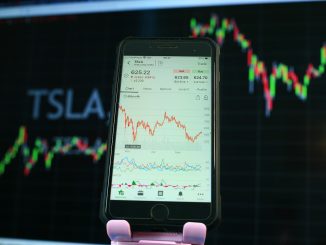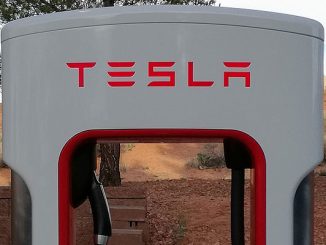My main issue with Elon Musk and Tesla is government subsidies. (An issue the WSJ shares, apparently. Though if commenter David Hoopes is right, they did not arrive at their opinion independently of me, given the echoes between my post and the WSJ’s subsequent oped. There are definite echoes.) If Tesla (NASDAQ:TSLA) can make it on its own, all power to it.
But I do have my doubts about its ability to deliver, standing on its own two feet. Though in expressing those doubts, I have to acknowledge that I am in conflict with Mr. Market, who is continuing to push TSLA on its hyperbolic path-up 13.65 freaking percent today. On what news? Got me.
My cognitive dissonance is intensified by the litany of bad news coming out about electric autos. Today Bloomberg ran a long article about the total fail of electric cars in Germany, despite ambitious government targets. Last Monday, Reuters ran a feature story on how the “road to a greener America is littered with road kill.” And perhaps the biggest news was the liquidation-not bankruptcy mind you, but liquidation-of battery swap innovator Better Place. This despite $850 million in investment, the support of a major auto company (Renault), and a marketing strategy directed at the most favorable markets (e.g., Denmark, Israel, and Hawaii).
There is a litany of electric car failures. Perhaps Musk/Tesla can be the exception that proves the rule, but color me skeptical.
Tesla has made waves with its high end Model S. But Daimler and BMW are about to introduce high end models of their own, and they can certainly beat Tesla on manufacturing cost and quality (given their long history of building luxury vehicles and Tesla’s manufacturing teething problems). Moreover, the technology is pretty standardized. People rave about the acceleration of a Tesla, but that’s purely an artifact of electrical motors: the new Daimler vehicle (described in the Bloomberg piece linked above) also has stellar acceleration.
Tesla plans to launch more affordable vehicles, but no one-no one-has succeeded in that space. The problems inhere in the technology:
“EVs are a really difficult sell today,” the CEO of Toyota’s North American business, Jim Lentz, said in an interview. “Until we see substantial change in battery technology it’s going to be difficult to see EVs really take off.”
Both articles-and many more, to boot-point to a fundamental issue: range and recharging capability. Here, the failure of Better Place should be truly sobering to the Tesla fan boys. It was specifically intended to address the range problem through battery switch technology, but sales of electric autos-even in the cherry-picked markets-were too small to make Better Place viable.
And this points out a fundamental chicken-and-egg aspect to electric cars, which in turn helps explain a good part of Musk’s strategy.
The demand for electric cars depends on the availability of charging facilities. Or, more accurately, the expected availability of charging facilities. It also depends on the expected speed of recharge, and the expected duration of a charge.
Charging stations seem to be a constant returns to scale technology. It is easy to expand capacity to reflect demand, just as it was/is easy to expand filling station capacity to accommodate the number of gasoline-powered cars on the road. Moreover, entry is relatively easy. That suggests the following simple model. The number of charging stations will adjust to accommodate the number of electric vehicles. But this leads to an indeterminacy resulting from a self-fullilling prophecy effect: if a small number of vehicles are sold, there will be a small number of charging stations. If a large number of vehicles are sold, there will be a large number of stations. If potential buyers suspect there will be a small number of other buyers, they will anticipate a small number of charging stations, and they will be less likely to purchase (or, more precisely, their reservation price will be low). If potential buyers think a lot of others will buy, they will anticipate a large number of charging stations, and they will be more likely to purchase (high reservation price).
Thus, there is a bandwagon effect in electric vehicles. The bandwagon works in part through the expected availability of charging services. This has a self-fullfilling element: if a lot of people jump on the electric car bandwagon, it will be profitable for people to invest in recharging facilities.
There are multiple equilibria in these circumstances. You can have low sales equilibria and high sales equilibria.
This is the perfect situation for a Music Man. A promoter who gets the bandwagon rolling. And this is exactly what Musk is trying to do.
Using Twitter in particular, he is trying to convince potential consumers that there will be a huge infrastructure of charging stations, and that these stations will be highly efficient, permitting a recharge in less time than it takes you to fill your SUV with gas.
Several problems here. The first is that the bandwagon effect may never kick in: it hasn’t so far, despite aggressive efforts by governments to get it started. The second is that creating a bandwagon is a public good in this instance: even if Musk starts an electric car bandwagon going, given the ability of myriad other auto manufacturers to enter the market, Tesla will only be able to capture a fraction of the sales resulting from the bandwagon.
You might find this analogy a stretch, but I am convinced it is apt: Elon Musk faces the same challenge as Ben Bernanke, and is using the same strategy. (And hey, the differences aren’t that great. Without a hair transplant, or plugs, or whatever he did with his pate, by now Musk would be a chrome-dome like Ben!) Bernanke wants to generate inflation. His ability to do so depends on his ability to shape inflationary expectations. There is a self-fulfilling prophecy aspect to this too, and as a result, there are multiple equilibria: you can have low inflation and high inflation equilibria, depending on whether people expect inflation to be low or high. So Bernanke and the Fed have resorted to various public statements to try to shape these expectations.
That is, there is a bandwagon effect in inflationary expectations, just as there is a bandwagon effect in the sales of electric vehicles. One strategy to get a bandwagon going is the Tinker Bell Strategy: I believe! I believe! Musk is attempting to get people to Believe! in electric cars through Twitter and other public pronouncements. Bernanke and the Fed are attempting to get people to Believe! in increasing inflation through public announcements and guidance.
It is a rational strategy for both to follow, given their objectives. I must say, though, that starting an inflation bandwagon is likely far easier than getting an electric car bandwagon going. Addressing the recharging issue is a necessary, but not sufficient condition to overcoming consumer reservations about electric cars. There are so many other limitations on performance that will make people reluctant to adopt.
But I get the strategy. If you are long Tesla, or contemplating going long, you need to understand what that strategy is and what must happen for it to succeed. If you buy Tesla, you are essentially buying an option on Musk being able to start a bandwagon, and get the self-fulfilling prophecy to work.
This also explains the need to build a cult of personality around Musk, all the better to enhance his oracle-like status: hence the employment of a Sock Puppet Army, the aggressive attacks on anyone who calls BS on the cars, or the company, etc.
It will either succeed wildly, or crash in humiliating failure. I think the fundamentals favor the latter, but in a multiple equilibrium world, I can’t rule out the former.





Leave a Reply